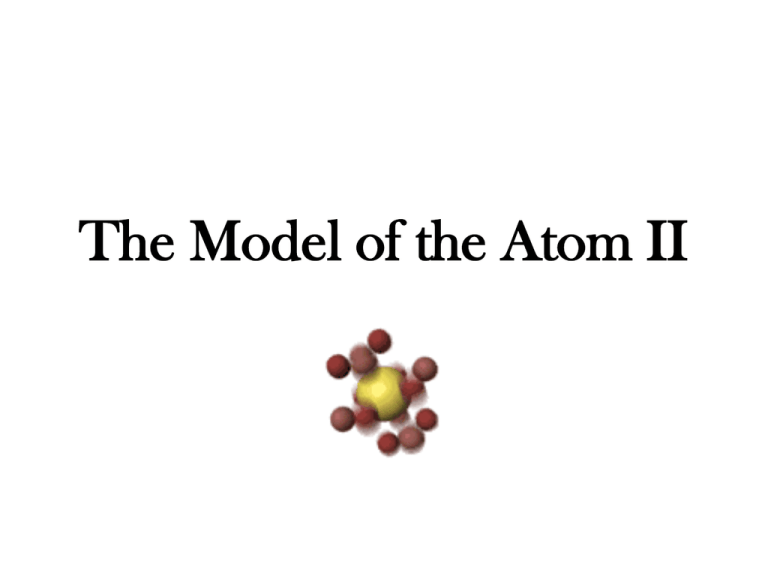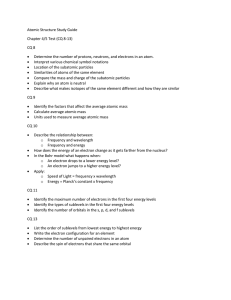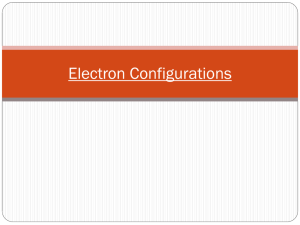The Model of the Atom
advertisement

The Model of the Atom II The Atom Review • Dalton’s Atomic Theory • All matter made up of atoms • Atoms are indivisible • Atoms of same element are exactly alike Dalton Was Wrong—But Not His Fault The Atom Review • Dalton’s Atomic Theory • Atoms ARE made of smaller particles • Neutrons – Discovery of isotopes Carbon-12, Carbon-14 • Protons – Rutherford’s Gold Foil experiment • Electrons – Thomson’s cathode ray experiment The Atom Electrons Most Important • Why? • Responsible for most chemical and physical properties • Responsible for chemical bonding – Covalent (sharing) & Ionic (transferring) • Understanding electron arrangement allows for understanding of chemical reactions Electromagnetic Spectrum (EMS) • RMIVUXG= Ronald McDonald Is Very Ugly & Xtremely Goofy. • • • • Radio> Microwave> Infrared> Visible> UV> X ray> Gamma Long >>> short wavelength Low frequency >>> high frequency Low energy >>> high energy Electromagnetic Spectrum (EMS) • Visible = ROYGBIV • Red>Orange>Yellow>Green>Blue>Indigo>Violet • Every element emits a different set of wavelengths, we can thus ID an element by its EMS. The Atom Energy Levels • Discovered by observing emissions spectra The Atom Energy Sublevels • Scientists Seeing Unexpected Results With Emissions Spectra • Hypothetical: only 3 energy levels, how many possible colors could be seen? 3 2 1 3 The Atom Energy Sublevels • Scientists Seeing Unexpected Results With Emissions Spectra • They were seeing a lot more spectral lines than what they expected • Only explanation: sublevels 3 2 1 The Atom Energy Sublevels • How many colors would you expect to see now? 3 19!! 2 1 The Atom Energy Sublevels • Given Abbreviations • From lowest energy to highest energy: – s, p, d, f • Each energy level has a corresponding number of sublevels Energy Level 1 1 Sublevel , 1s Energy Level 2 2 Sublevels, 2s,2p Energy Level 3 3 Sublevels, 3s, 3p, 3d Energy Level 4 4 Sublevels, 4s, 4p, 4d, 4f The Atom Energy Sublevels • Each sublevel has a specific number of orbitals: s p d f 2 (1 orbital) 6 (3 orbitals) 10 (5 orbitals) 14 (7 orbitals) The Atom Energy Sublevels • Each orbital can hold only TWO electrons: s p d f 2 (1 orbital-2 total electrons) 6 (3 orbitals-6 total electrons) 10 (5 orbitals-10 total electrons) 14 (7 orbitals-14 total electrons) The Atom Energy Levels • Each energy level then has a set number of sublevels and maximum electrons: 1 – only s 2 electrons max 2- s and p sublevels, 8 electrons max 3- s, p, and d sublevels, 18 electrons max 4- s, p, d, and f sublevels, 32 electrons max The Atom Electron Orbitals • Regions in space where electrons are likely to be found • Follows electron cloud model – Electrons do not travel in a specific orbit • Each orbital holds maximum of 2 electrons • Electron configuration – When all electrons are in most “comfortable” orbital and energy level The Atom Orbital Shapes The Atom Electron Orbitals • Snapshot Analogy The Atom Electron Orbitals • Snapshot Analogy The Atom Electron Orbitals • Snapshot Analogy The Atom Electron Orbitals • Snapshot Analogy The Atom Electron Orbitals • Snapshot Analogy The Atom Electron Orbitals • Snapshot Analogy The Atom Electron Orbitals • Snapshot Analogy The Atom Electron Orbitals • Snapshot Analogy The Atom Electron Orbitals • Snapshot Analogy Orbital Shape The Atom Electron Configurations • Rules to tell you in what order the orbitals get filled • Aufbau principle • LOWEST energy orbitals get filled FIRST • Pauli exclusion principle • Each orbital can only hold TWO electrons— each with opposite “spin” • Hund’s Rule • Each orbital must have ONE electron before any has TWO Electron Configurations • Aufbau principle • 1s gets filled before 2s, 2s before 2p etc. (see “arrow chart”) • Pauli exclusion principle • Boxes often represent orbitals • Hund’s Rule 2s 2px 2py 2pz Writing Electron Configurations • The electron configuration for H is 1s1 • The e- configuration for He is 1s2 • Li = 1s22s1 • Na = 1s22s22p63s1 • Notice that the superscripts should add up to the total number of electrons! Sodium 1s 11 electrons 2s 2p 3s 3p 3d 4s 4p 4d 4f 5s 5p 5d 5f 6s 6p 6d 6f 7s 7p 1s22s22p63s1 Electron Configurations EXCEPTIONS • Some elements do NOT follow all the rules • Copper • Expected: Cu- 1s22s22p63s23p64s23d9 4s 3dxy 3dxz 3dyz 3dx2-y1 3dz2 Electron Configurations EXCEPTIONS • Some elements do NOT follow all the rules • Copper • Expected: Cu- 1s22s22p63s23p64s23d9 • Actual: Cu- 1s22s22p63s23p64s13d10 4s 3dxy 3dxz 3dyz 3dx2-y1 3dz2 Partially-filled 3d sublevel, with a filled 4s is less stable than a filled 3d and a half-filled 4s Kernel Structures Electron Configurations • Can get very long as you go down the PT • Kernel structures are used as abbreviations • The “kernel” is ALWAYS a Noble Gas (group 18) • They represent all inner electrons Kernel Structures Electron Configurations Iodine 1s22s22p63s23p64s23d104p65s24d105p5 Tellurium 1s22s22p63s23p64s23d104p65s24d105p4 Antimony 1s22s22p63s23p64s23d104p65s24d105p3 Tin 1s22s22p63s23p64s23d104p65s24d105p2 Kernel Structures Electron Configurations Iodine 1s22s22p63s23p64s23d104p65s24d105p5 Find the noble gas that comes BEFORE the element Krypton [Kr]5s24d105p5 The End






